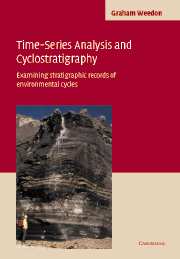Book contents
- Frontmatter
- Contents
- Preface
- Acknowledgements
- Chapter 1 Introduction
- Chapter 2 Constructing time series in cyclostratigraphy
- Chapter 3 Spectral estimation
- Chapter 4 Additional methods of time-series analysis
- Chapter 5 Practical considerations
- Chapter 6 Environmental cycles recorded stratigraphically
- Appendix – published algorithms for time-series analysis
- References
- Index
Chapter 6 - Environmental cycles recorded stratigraphically
Published online by Cambridge University Press: 13 August 2009
- Frontmatter
- Contents
- Preface
- Acknowledgements
- Chapter 1 Introduction
- Chapter 2 Constructing time series in cyclostratigraphy
- Chapter 3 Spectral estimation
- Chapter 4 Additional methods of time-series analysis
- Chapter 5 Practical considerations
- Chapter 6 Environmental cycles recorded stratigraphically
- Appendix – published algorithms for time-series analysis
- References
- Index
Summary
Introduction
There are a varietyof environmental processes that have been used to explain regular cycles encountered in stratigraphic records (in the broad sense from growth bands in living organisms and fossils to layered ice, speleothems, sediments and sedimentary rocks). This chapter provides brief introductions to some of the relevant issues for each process and attempts to give some insight into the nature of the stratigraphic records involved.
The periodic and quasi-periodic processes discussed here range through many magnitudes in terms of their characteristic period and they are discussed in the order of increasing duration. However, all these environmental cycles are expressed via changes in climate and/or, in the case of tidal records and some continental shelf orbital-climatic records, via changes in sea-level. The discussions only consider cycles with a reasonably well-documented stratigraphic expression. Thus, although the day/night cycle, caused by Earth's rotation, apparently accounts for microscopic growth increments in corals (Wells, 1963; Cohen et al., 2001), this aspect of coral growth does not appear to have been studied using time-series analysis. Additionally, there are several types of atmospheric and oceanic variability that are only now being investigated and for which convincing stratigraphic records have yet to be found (e.g. decadal variability in the Indian Ocean, e.g. Saji et al., 1999; Webster et al., 1999). Not discussed are processes not primarily driven by climate and/or sea-level. Such processes include, for example, autocyclic processes in fluvial systems (Schwarzacher, 1993; cf. Peper and Cloetingh, 1995), fault activity (Cisne, 1986; Ito et al., 1999; Morley et al., 2000) and volcanic impacts on global temperatures (e.g. Stuiver et al., 1995; Briffa et al., 1998a).
- Type
- Chapter
- Information
- Time-Series Analysis and CyclostratigraphyExamining Stratigraphic Records of Environmental Cycles, pp. 161 - 216Publisher: Cambridge University PressPrint publication year: 2003



